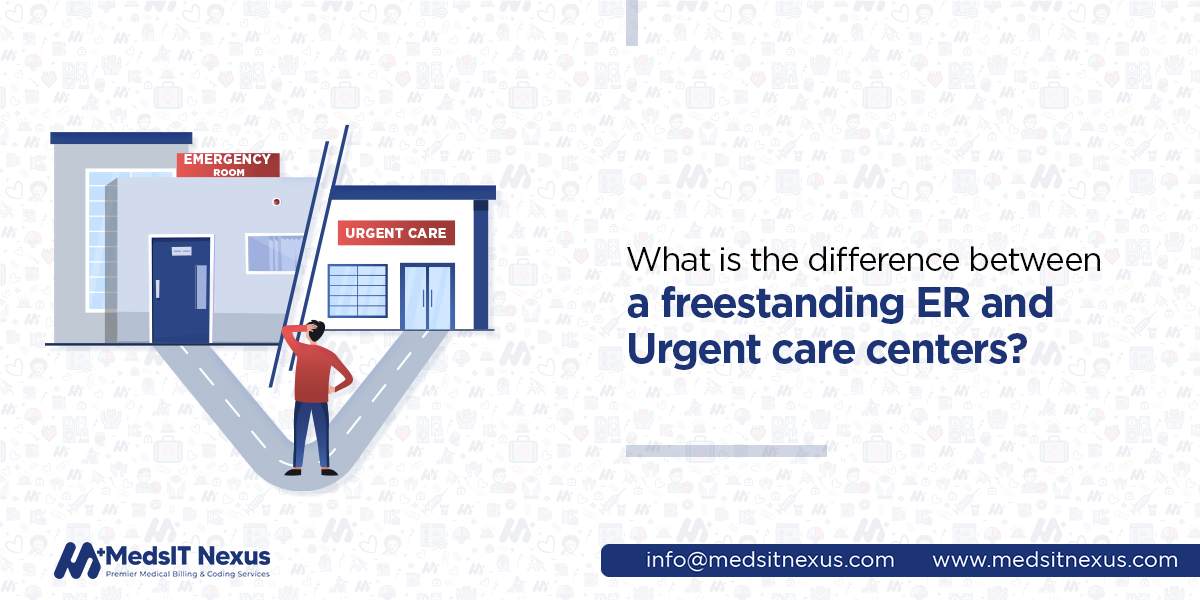What is the Difference Between a Freestanding ER and Urgent Care Centers?

Many believe that urgent care centers and freestanding emergency rooms are identical. There is a myth that urgent care centers are the alternative to emergency rooms, which is wrong. This perception of people causes them to be perplexed about where to go for treatment, depending on how severe their condition is. Both terms are widely different. In this regard, you should know, “What is the difference between a freestanding ER and urgent care centers?”
Freestanding emergency rooms and urgent care facilities provide patients with exceptional and valuable advantages, but their functions and offerings are sometimes muddled, with cost playing a big part. Healthcare professionals must be aware of this widespread misunderstanding when counseling their patients. Hence, to be very precise, the freestanding emergency room is a place to go when you need instant treatment for a severe illness that is life-threatening, such as a heart attack. Contrarily, urgent care centers should be visited to get treatment for a disease that is not life-threatening, such as fever. Let’s dive into the apparent differences between both so that it becomes easy for you to decide where to go depending on your condition.
Levels of services
Freestanding ER
Whenever a life-threatening condition requires immediate treatment and care, freestanding emergency rooms come in handy. The conditions mentioned below would demand a freestanding ER;
- Severe burn
- Heart attack
- Severe abdominal pain
- Severe bleeding
- Cancer
- Fractures
- Unconsciousness
- Head injuries
- Stroke
- Shock
- Animal bite
Urgent care centers
The urgent care center is the option for non-life-threatening injuries and conditions. In these, the physician’s assistant, nurse, or the physician himself can see and treat the patient. The states in which an urgent care center is required are;
- Allergies
- Vaccination
- Small lacerations
- Flu
- Cuts
- Sprain
- Vomiting
- Minor infection
- Fever
- Minor burns
- Rash
Cost
Urgent care center: Another prevalent misunderstanding about costs exists. People sometimes wrongly assume that a freestanding ER must be as expensive as an urgent care facility since they frequently conflate the two types of facilities. The co-payment for visiting an urgent care facility is often greater than seeing a primary care physician but far less than going to the emergency department. They have lesser administration fees since they have fewer working hours, lack of latest imaging technology, and many more hence always seen that they charge far less than emergency rooms.
Freestanding ER:The fees in a freestanding ER are often equivalent to those at an emergency room inside a hospital if a patient’s condition justifies going there, showing that its cost is much higher than urgent care center.
Hours and staff
Freestanding ER: A freestanding emergency room’s services are available 24 hours a day, day and night. The services and treatment rendered in the freestanding ER are provided by trained staff and physicians. However, the American College of Emergency Physicians created a policy statement that considers all freestanding EDs must adhere to. According to ACEP, facilities should have competent emergency doctors on staff and be open to people 365 days a year, 24 hours a day. (2)
Urgent care centers Urgent care centers are not available 24/7 and are mostly not open at night. They are primarily open for 13 hours. Moreover, a doctor’s assistant or nurse can also see and treat a patient. According to a 2014 Urgent Care Association of America survey, “About 80% of urgent care centers use a combination of doctors, physician assistants, and nurse practitioners to deliver care, while the remaining 20% use doctors exclusively.” (1)
Waiting time
Freestanding emergency departments and urgent care centers have fewer waiting times, and in most cases, the waiting times for both are exact.
What are the similarities and differences between freestanding and hospital ERs?
An urgent care center and a freestanding ER have differences; likewise, a hospital emergency room and a freestanding emergency room have differences. However, freestanding emergency rooms resemble hospital emergency rooms in many aspects too. Before any further ado, let’s talk about the similarities and differences.
Similarities between freestanding emergency rooms and hospital-based emergency rooms
As both the Hospital Emergency rooms and freestanding emergency rooms are emergency departments, they have many things identical to each other. The significant similarities between both are;
- Both emergency rooms operate 24/7, meaning they work 24 hours a day and seven days a week. They are always available to provide high-quality services at any time.
- Both offer access to medical physicians, emergency staff and nurses, radiology and laboratory technicians, and specialists in complex imaging techniques, including ultrasound and computed tomography.
- Both forms of ER cost around the same. An article titled “Comparing Freestanding EDs, Hospital-Based EDs, and Urgent Care in Texas” claims, “Prices charged by freestanding EDs nearly resemble those of hospital-based EDs.” The cost difference, if any, would be negligible. But both types of emergency rooms have fees much higher than urgent care centers because of the types of services they render.
- Not only hospital emergency rooms but also freestanding emergency rooms deal with potentially fatal illnesses, including fractures, bleeding, breathing issues, heart attacks, strokes, and more.
- Both emergency rooms have cutting-edge tools and technology for surgery, treatment, and diagnosis, among other things.
- FSER, as well as the hospital ER, immediately renders life-saving assistance to patients.
- Take ultrasound, x-ray, and CT scans.
Differences between freestanding and hospital ERs
Although both have similarities, they have some prominent differences that must involve your knowledge. Those differences include;
Their ownership may vary
A freestanding emergency room has independent ownership, is not connected to a hospital, and works independently. It can be owned by a health system, a hospital, or a private clinic. There is no restriction that it must be attached or, if attached, it must connect to a hospital only.
A hospital ER provides easier hospital admission
Given that it is connected to a hospital, this is definite. If you are in a freestanding ER and it is concluded that you require hospitalization, you will be transported to a hospital in an ambulance. Private freestanding ER typically establishes arrangements with local hospitals to ensure that patients are admitted as soon as possible.
A freestanding ER has more “walk-in” patients
In other words, most individuals who attend a freestanding emergency department come independently rather than being transported by ambulance. In comparison, around 40% of hospital ER patients arrive in an ambulance. Waiting time is shorter in duration in freestanding emergency departments.
Level of care
A freestanding ER cannot provide trauma care and may refer you to a hospital ER depending on your medical condition. Trauma care and other treatments are provided at hospital-based ERs.
Wait times can vary between emergency rooms and FSERs
Every emergency department follows a set process for assessing the severity of each patient’s situation and distributing resources appropriately, ensuring that those in the most need are seen first. Wait periods for FSERs may also vary, although their various accessible locations might be advantageous because patients may be more distributed over the area, resulting in a lower wait time.
Why choose MedsIT Nexus for your emergency departments and urgent care centers?
Be it the emergency department or your urgent care facility, MedsIT Nexus is there for you to handle all of the billing services of your organization. While you deal with your patients thoroughly, MedsIT Nexus medical billing and coding services aid your facility in reducing the burdensome billing process by running it flawlessly and skillfully to increase the reimbursement of your urgent care center by up to 30%. Using all the HIPAA-complaint services, our experiencedmedical billing staff will start professional billing steps at the front desk and maintain accuracy to ensure profit for your facility.
Samuel White, MBA-HC, CPAR -
Lead Author & Senior Healthcare Revenue Cycle Strategist at MedsIT Nexus
Leads editorial process for the publication of Technical RCM guides, reimbursement optimization case studies, and compliance-focused research content, expert evaluations of RCM software and medical billing solutions.
Other Editors
Table of Contents

Services
- Medical Audit Services
- Medical Billing Services
- Medical Credentialing Services
- Medical Coding Services
- Accounts Receivable Management
- Medical Insurance Verification
- Denial Menagement Services
Who we serve
- Private Practices
- Small Practices
- Hospitals & Healthcare
- Physicians
- Medical Equipment
- Outpatient Facilities
Get in Touch
Let's start talking about getting you credentialed
Related Posts

How to retain patients in a new era of urgent care?




